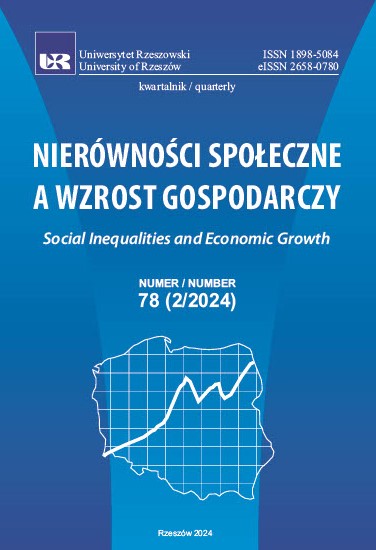Economic growth, inflation, unemployment – interdependencies using examples from selected countries
DOI:
https://doi.org/10.15584/nsawg.2024.2.4Keywords:
GDP, inflation, unemployment, United Kingdom, Switzerland, RomaniaAbstract
The paper attempts to answer the question of how, in the existing complexity of external stimuli, phenomena and processes that affect economies, their economic situation is presented taking into account the state and interdependencies of basic macroeconomic aggregates.
The main objective of the research was to diagnose the directions and interdependencies between basic macroeconomic aggregates of selected economies, i.e. Switzerland, the United Kingdom, and Romania, in 2012–2022. A theoretical, analytical and empirical verification of interdependencies of selected macroeconomic aggregates was performed. It was assumed that the strongly differing views in the literature on the economic condition of the world are a resultant of the individual macroeconomic situations of the economies and that the economies under study do not necessarily represent radical and extreme views. Selected procedures of scientific explanation and research, i.e. analysis and evaluation of the object of research, system analysis and synthesis, and generalisation of research results, were used to solve the research problem posed and verify the research hypothesis, and inference was given on this basis. The applied macroeconomic analysis is a study covering the state of the economy and the projections of economic growth, inflation, unemployment, and the interdependencies occurring within countries between these aggregates. It involves the study and evaluation of economic quantities that are aggregated, i.e. mainly captured for the national economy as a whole. Analysing the examples of Switzerland, the UK, and Romania, it can be seen that stable and balanced economic growth is conducive to low inflation and low unemployment. However, each country has its own unique challenges and conditions that affect the interplay between these macroeconomic indicators. Understanding these interrelationships is key to developing effective economic policies that promote sustainable growth, control inflation, and keep unemployment rates low.
Downloads
References
Adach-Stankiewicz, E., Białek, J., Bielak, R., Bobel, A., Dominiczak-Astin, A., Turek, D., Wyżnikiewicz, B. (2019). Co warto wiedzieć o inflacji? Warszawa: GUS.
Apanowicz, J. (2005). Metodologiczne uwarunkowania pracy naukowej. Warszawa: Centrum Doradztwa i Informacji Difin.
Begg, D., Fischer, S., Dornbusch, R. (2007). Makroekonomia. Warszawa: PWE.
Informator ekonomiczny. Szwajcaria. Pobrane z: https://www.gov.pl/web/szwajcaria/ie (2024.04.25).
Informator ekonomiczny. Wielka Brytania. Pobrane z: https://www.gov.pl/web/wielka-brytania/informator-ekonomiczny (2024.04.25).
Informator ekonomiczny. Rumunia. Pobrane z: https://www.gov.pl/web/rumunia/informator-ekonomiczny (2024.04.25).
Trading Economics. PKB per capita. Lista krajów – Europa. Pobrane z: https://pl.tradingeconomics.com/country-list/gdp-per-capita?continent=europe (2024.04.25).
Trading Economics. Wielka Brytania – PKB. Pobrane z: https://pl.tradingeconomics.com/united-kingdom/gdp (2024.04.25).
Trading Economics. Rumunia – PKB. Pobrane z: https://pl.tradingeconomics.com/romania/gdp (2024.04.25).
Trading Economics. Szwajcaria – PKB. Pobrane z: https://pl.tradingeconomics.com/switzerland/gdp (2024.04.25).
Historic harmonised inflation Great Britain – HICP inflation. Pobrane z: https://www.inflation.eu/en/inflation-rates/great-britain/historic-inflation/hicp-inflation-great-britain.aspx (2024.04.25).
Trading Economics. Romania Harmonised Inflation Rate YoY. Pobrane z: https://tradingeconomics.com/romania/harmonised-inflation-rate-yoy (2024.04.25).
Trading Economics. Switzerland Harmonised Inflation Rate YoY. Pobrane z: https://tradingeconomics.com/switzerland/harmonised-inflation-rate-yoy (2024.04.25).
ONS. UK. Female unemployment rate (aged 16 and over, seasonally adjusted): %. Pobrane z: https://www.ons.gov.uk/employmentandlabourmarket/peoplenotinwork/unemployment/timeseries/mgsz/lms (2024.04.25).
INSSE. National Institute of Statistics. Romania. Pobrane z: https://insse.ro/cms/ (2024.04.25).
SECO. State Secretariat for Economic Affairs. Switzerland. Pobrane z: https://www.seco.admin.ch/seco/en/home.html (2024.04.25).
Kolasa, M. Przegląd gospodarek europejskich 2024. Polski Fundusz Rozwoju, Warszawa. Pobrane z: https://pfr.pl/ekspertyzy-ekonomiczne/przeglad-gospodarek-europejskich-maj-2024-r.html (2024.06.20).
Kołodko, G.W. (2020). Ekonomia nowego pragmatyzmu: tożsamość, cele, metoda. Ekonomista, 2, 181–205. DOI: https://doi.org/10.52335/dvqp.te161.
Kornai, J. (2014). Dynamizm, rywalizacja i gospodarka nadmiaru. Kraków: Fundacja GAP.
Lagarde, Ch. Raport roczny (2022), Europejski Bank Centralny, Frankfurt nad Menem, maj 2023. Pobrane z: https://www.ecb.europa.eu/press/annual-reports-financial-sta-tements/annual/html/ecb.ar2022~8ae51d163b.pl.html (2024.05.17).
Europejski Bank Centralny – Eurosystem, Co to jest inflacja? Pobrane z: https://www.ecb.europa.eu/ecb-and-you/explainers/tell-me-more/html/what_is_inflation.pl.html (2024.04.25).
Okun, A. (1962). Potential GNP: Its Measurement and Significance. W: Proceedings of the Business and Economics Section (s. 98–103). American Statistical Association.
Phelps, E. (1972). Inflation Policy and Unemployment Theory. London: Macmillan.
Rozporządzenie Parlamentu Europejskiego i Rady (UE) nr 549/2013 z dn. 21.05.2013 r., Dziennik Urzędowy Unii Europejskiej, L 174, Tom 56, Legislacja 26 czerwca 2013.
Ślusarczyk, B., Ślusarczyk, S. (2011). Podstawy mikro- i makroekonomii. Lublin: Politechnika Lubelska.
Światowy Raport Inwestycyjny 2023. Pobrane z: https://unctad.org/publication/world-investment-report-2023 (2024.05.20).
Zeszyt metodologiczny. Statystyka rynku pracy i wynagrodzeń. (2020). Warszawa: GUS. Pobrane z: https://stat.gov.pl/files/gfx/portalinformacyjny/pl/defaultaktualnosci/5818/1/3/1/zeszyt_metodologiczny_statystyka_rynku_pracy_i_wynagrodzen_2021.pdf (2024.05. 28).
Downloads
Published
How to Cite
Issue
Section
License
Copyright (c) 2024 University of Rzeszow

This work is licensed under a Creative Commons Attribution-NonCommercial-NoDerivatives 4.0 International License.


